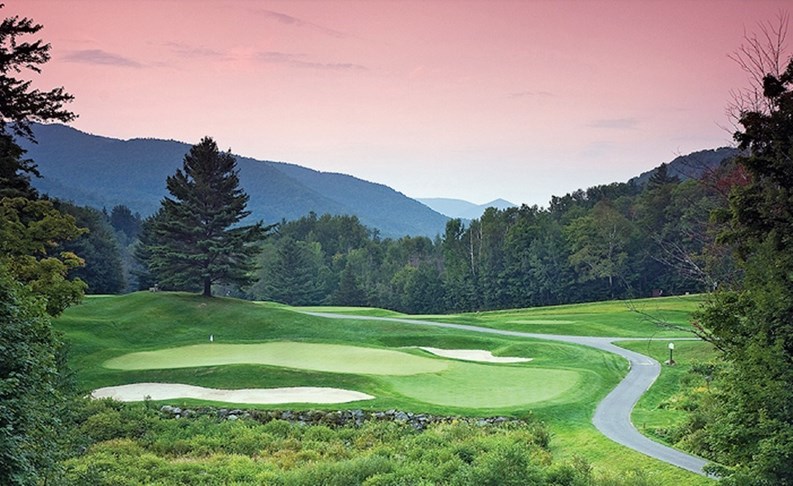To ski or not to ski: that is the question in Killington, Vermont.
Known as the best skiing in the East, it is hard to separate Killington from skiing. Dominated by the Killington-Pico Resort, the town of Killington is a thriving winter resort that draws over 15,000 skiers on its busiest days.
But it is not skiing that draws the stream of bikers who roar through Killington for “Thunder through the Mountains,” the town-sponsored motorcycle rally held every September. And it is the cool green of a Vermont summer, rather than drifts of snow, that draws hikers and retirees from Florida to Killington.
Dariece Kirby-Kline of Killington’s Economic Development and Tourism Department explains, “It’s true that winter is our busiest season and most of our businesses are concentrated around skiing; but we transform in the summer and our ski shops turn to bike shops and we focus on summer tourism.” Killington’s numerous restaurants, hotels, inns and nightclubs are eager to serve visitors all year round.
Located in central Vermont at the base of the Green Mountain National Forest, Killington was originally chartered in 1761. The town changed its name to Sherburne in 1800 and remained Sherburne for almost 200 years. In 1999, the name was returnedto the original Killington to correct confusion and solidify the town’s relationship to the mountain.
The mountain – really a series of seven summits - separates the town of Killington from the city of Rutland. On a clear day you can see the surrounding five states as well as Canada from the top of Killington Peak (elevation of 4,241 feet). Look closely andyou will see snaking through these peaks not only hundreds of ski runs, but also mountain bike trails, alpine slides, horseback trails and miles of exceptional hiking trails, including sections of the Long Trail and of the renowned Appalachian Trail.
50 Years of Skiing
While nearly 250 years old, Killing-ton did not make the proverbial map until it first opened for skiing on Dec. 13, 1958, using a converted chicken coop for a ticket booth. According to the Chamber of Commerce, KillingtonPeak and Pico Peak were originally owned by Mortimer Proctor of the Vermont Marble Company. Over the years, it expanded and changed hands a number of times. In 2007, it was purchased by the SP Land Co. and Powdr Corp. and increased capital investment and renewed discussion of a slope-side “village” have helped create a sense of optimism concerning the new owners.
Despite transfers in ownership, one fact has remained constant in 50 yearsof skiing: Killington dwarfs nearby resorts in scale and terrain. With the acquisition of Pico Peak in 1996, the resort today encompasses seven peaks, 1,200 acres of slopes, nearly 200 trails and 30 lifts. The hardy can descend for an impressive six miles on “The Juggernaut,” the resort's longest run.
At the height of the winter season, 1,600 employees are required to keep the resort operating. But skiing also requires snow. And Killington has snow. One of the first resorts to make snow in the 1960s, Killington today boasts an impressive snowmaking system, along with an average natural snowfall of 250 inches. Together, this produces enough snow to allow Killington, dubbed “the Beast of the East,” to claim the longest ski season in Eastern North America.
A Small Town with Many People
Despite its immense scale and popularity, congestion remains under control in Killington. The resort is easily accessible from U.S. Route 4 and Vermont 100, which prevents single entry bottlenecks. Traffic is further diluted because of the layout of the resort:: it stretches nearly 10 miles, has four entry points, five base lodges and seven parking lots. A popular shuttle, “The Bus” runs between the parking lots and lodges, as well as through Killington Village resort properties and down Killington Road.
By car, Killington is about five hours from New York City (NYC) and about three hours from Boston. Amtrak also offers daily service from NYC to Rutland, Vermont (11 miles from Killington), from which a shuttlebus takes visitors to the ski resort.
According to Bill Vines, an owner of the Birch Ridge Inn, the majority of visitors he sees originate from “alongthe I-95 corridor.” Vines estimates that about a third of his guests are from the Boston area and more than a third from the NYC/tri-state area. Of the remainder of his guests, nearly 10% come from abroad – primarily from the UK.
Year-round residents, Vines says, include essentially three groups of people: those in the tourist trade, retirees, and those who moved to Killington simply to live in a nice little Vermont town.
Primarily Second Homes
Killington’s population of just over 1,000 year-round residents is seriously outnumbered by seasonal visitors and second-home owners. The Vermont Housing Finance Agency classifies almost four-fifths of the overall housing stock in Killington as “for seasonal, recreational or occasional use” in the most recent Vermont Housing Data Report. According to Patrick Whelan, a lister for the town of Killington, there are 918 single-family homes in Killington, of which only 260 are year-round residences. There are 1,526 condominiums classified and registered as “vacation properties” by the town. Most condominiums in Killington can be found in one of the approximately 20 condominium complexes. These complexes range from the very upscale – with amenities like pools, spas, and tennis courts –to rustic old-school.
The most expensive condominium currently on the market is a three-bedroom, five-bath unit listed at $1.4 million. The low end of the price spectrum is a one-bedroom, one-bath unit listed for $59,000. The majority of condominiums for sale are priced at less than $250,000. Whelan explains that finding an average is difficult because prices within real estate categories can vary drastically, often due to proximity to the slopes. Whelan does observe that real estate prices in the past few years have remained relativelyflat overall, but sales have dropped considerably.
Real Estate Market Finally Looking Up
Heidi Bomengen of Prestige Realty of Killington agrees that sales have dropped more drastically than prices. Because most of Killington’s properties are vacation homes, there is very little urgency to buy or sell. Many owners are able and willing to hold on to their property until the market picks up and they can get the price they want. She clarifies that while Killington may have fared better than some ski resorts, condominium prices are still down – an average of 10% a year from 2006, according to her firm’s analysis of the local market, “Killington Real Estate in Review.” But volume has suffered even more. “Sales are way down from the peak in 2005,” she explains. “In 2005, there were 130 condos sold; in 2008, only 50 all year. Our very worstperiod was the last quarter of 2008 and the first quarter of 2009.” There is now optimism that the slump is over, however.
With an immensely popular natural playground, small town atmosphere and strategically accessible location, Killing-tonhas reason to be optimistic.
Sarah Sanford is a freelance writer and a frequent contributor to New England Condominium magazine.







Leave a Comment